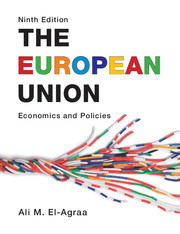Book contents
- Frontmatter
- Contents
- Figures
- Tables
- Boxes
- Contributors
- Preface
- A reader’s guide
- Abbreviations
- 1 General introduction
- Part I EU history, institutions and legal dimension
- Part II EU market integration
- 6 The theory of economic integration
- 7 The economics of the single market
- 8 Factor mobility
- 9 Measuring the economic impact of European integration
- Part III EU monetary integration
- Part IV The single European market
- Part V EU budget and structural policies
- Part VI EU external relations
- Part VII The future of the EU
- Bibliography
- Author Index
- Index
- References
6 - The theory of economic integration
from Part II - EU market integration
- Frontmatter
- Contents
- Figures
- Tables
- Boxes
- Contributors
- Preface
- A reader’s guide
- Abbreviations
- 1 General introduction
- Part I EU history, institutions and legal dimension
- Part II EU market integration
- 6 The theory of economic integration
- 7 The economics of the single market
- 8 Factor mobility
- 9 Measuring the economic impact of European integration
- Part III EU monetary integration
- Part IV The single European market
- Part V EU budget and structural policies
- Part VI EU external relations
- Part VII The future of the EU
- Bibliography
- Author Index
- Index
- References
Summary
Introduction
In reality, some existing schemes of economic integration, especially the EU, were either proposed or formed for political reasons, even though the arguments popularly put forward in their favour were expressed in terms of possible economic gains. However, no matter what the motives for economic integration are, it is still necessary to analyse the economic implications of such geographically discriminatory groupings; that is why I included political unions as schemes of economic integration in Chapter 1 (see Section 1.2, page 1).
The chapter begins with a static analysis of the effects of economic integration on trade and production, first in partial- and then in general-equilibrium terms; static in the sense of immediate effects that do not allow for changes in consumption and production patterns. It goes on to examine these effects in dynamic terms, allowing time for changes to occur in the consumption and production patterns. Domestic distortions in the markets are then included, followed by the incorporation of changes in international prices on the analysis. Then elements of factor mobility are ushered in before various other considerations are briefly dealt with and conclusions stated. It should be stressed, however, that this chapter requires an understanding of trade theory, but the basic concepts involved have already been introduced in the introduction to this part of the book.
- Type
- Chapter
- Information
- The European UnionEconomics and Policies, pp. 83 - 101Publisher: Cambridge University PressPrint publication year: 2011
References
- 1
- Cited by



